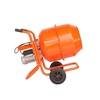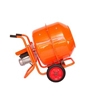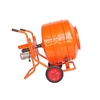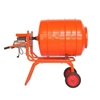A concrete mixer, also known as a cement mixer, is a specialized machine designed to automate the process of mixing cement, aggregates (such as sand, gravel, or crushed stone), and water to create concrete. This essential construction tool is widely used in projects ranging from residential DIY jobs to large-scale infrastructure developments. Its ability to produce consistent, high-quality concrete makes it an indispensable piece of equipment in the construction industry. In this blog, Tool.com outline concrete mixer selection tips to help you make an informed purchase.
Concrete Mixer Price List
Concrete Mixer Composition
A concrete mixer consists of several essential components that work together to ensure efficient and uniform mixing of concrete. At its core is the mixing drum, typically made of durable steel, which rotates to blend cement, aggregates, and water. Inside the drum, blades or paddles facilitate thorough mixing, while the drum's rotation is powered by a motor or engine—either electric, gasoline, or diesel. The mixer is supported by a sturdy frame and base, often equipped with wheels and handles for easy mobility on construction sites. A discharge system allows for precise pouring of the mixed concrete, with manual or hydraulic options for tilting the drum. Advanced mixers may include a hopper for easier loading of materials, a control system for adjusting speed and operation, and a water supply system for achieving the desired mix consistency. Additional features such as safety locks, overload protection, and stable bases ensure safe and reliable operation. The combination of these components makes a concrete mixer a vital tool for achieving consistent, high-quality concrete for various construction projects.
Tips for Choosing the Right Concrete Mixer
Choosing the right concrete mixer is essential to ensure efficiency, productivity, and high-quality results in your construction projects. Start by assessing your project needs, such as the size and scope of the work. For smaller tasks like DIY repairs or garden pathways, a portable mixer with a capacity of 2–5 cubic feet is ideal, while larger projects require medium to large mixers with capacities ranging from 6 to over 13 cubic feet. Next, decide on the power source—electric mixers are quiet and eco-friendly, making them suitable for residential and indoor use, whereas gasoline or diesel-powered mixers offer higher power for heavy-duty tasks in remote or outdoor areas.
Portability and durability are equally important. Lightweight mixers with wheels and handles are easier to move across job sites, while stationary mixers provide stability for continuous mixing. Look for mixers made of heavy-duty materials like steel to withstand wear and tear, and ensure the drum and frame are built to handle abrasive materials like cement and aggregates. Maintenance is another critical factor; choose a mixer that is easy to clean and check for the availability of spare parts. Some advanced mixers even come with self-cleaning systems, reducing manual labor and downtime.










